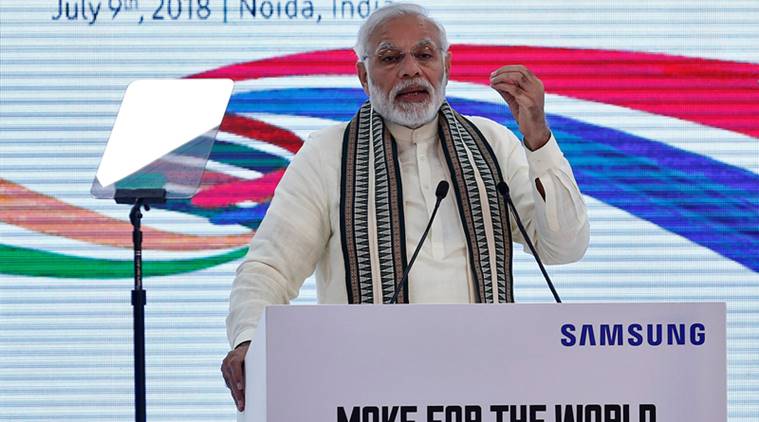 Prime Minister Narendra Modi speaks during the inauguration of the Samsung Electronics smartphone manufacturing facility in Noida. (REUTERS)
Prime Minister Narendra Modi speaks during the inauguration of the Samsung Electronics smartphone manufacturing facility in Noida. (REUTERS)
Prime Minister Narendra Modi declared that India has emerged as the second-largest mobile phone producer in the world, thanks to the ‘Make in India’ initiative his government started four years ago. He was speaking at the inauguration ceremony of the “world’s biggest mobile phone factory” in India set up by Samsung Electronics in Noida, Uttar Pradesh. The new initiative by the South Korean major is the latest attempt to penetrate deeper into India, the world’s fastest growing mobile phone market.
With the help of the new manufacturing facility, Samsung aims to double its annual mobile phone production capacity from 68 million at present to 120 million units per year once the phase-wise expansion is complete. This means the company wants to manufacture at least 1 crore phones per month by 2020, as part of a road-map to export 30 per cent of mobile phones from India to other markets.
In 2017, Samsung had announced it would invest Rs 4,915 crore to add new capacity at the Noida plant, which was set up in 1996. The company currently makes all of its mobile phones at the Noida plant, including the flagship Galaxy S9 and S9+. Samsung has been manufacturing mobile phones in India since 2007. “Samsung leads the market in terms of local value addition in India. Scaling up its operations gives Samsung an advantage to reduce the time to market and bringing some local features to the devices powered by R&D here,” Tarun Phatak, Associate Director, Mobile Devices and Ecosystem at Counterpoint Research, told indianexpress.com. He said the expansion of the manufacturing unit will also bring in export opportunity for Samsung to SAARC and other regions.
PM Modi said India has around 120 mobile phone manufacturing units scattered around the country, and out of which 50 of them are present in Noida. Till date, Samsung has provided overall employment to 70,000 people, and the new plant will add 1,000 more direct jobs. “India is amongst the top 5 smartphone markets globally for Samsung and with the new capacity in place, it can manufacture more low and mid-end devices locally as compared to its competition who are largely dependent on their base manufacturing in China currently,” said Upasana Joshi, Associate Research Manager at IDC India. She added: “It will certainly open more avenues for local manufacturing in India as more and more vendors in the ecosystem shift to establishing such facilities.”
Although Samsung has taken a calculated step to expand its manufacturing facility in India, it may not bring smartphone prices down. “There will not be much impact on prices as there were no price increases earlier also post the duty hikes came in place. Samsung, through its new unit, is just adding to the existing SMT lines in India,” she explained. Over the past year or so, Samsung’s market share in the Indian smartphone has taken a beating.
According to Counterpoint Research, Xiaomi had 31.1 per cent and Samsung was second with 26.2 per cent market share in Q1 2018. The former recently announced the opening of three new plants – including the company’s first SMT (Surface Mount Technology) plant aimed towards local manufacturing of PCBA (Printed Circuit Board Assembly) in India.
“With the current scenario of duty hikes in place by the Indian government and restricting dependence on imports, brands are looking out for opportunities to set up SMT (Semi Mounted techniques) facility; also referred as CKD (Completely Knock down) type manufacturing which requires high set up cost and availability of highly skilled labour to work in these facilities,” said Joshi.
“Bigger brands like Samsung, Xiaomi already have their setup in India. However, there are quite a few which are still evaluating the process and are vulnerable to it owing to smaller volumes in comparison to input cost. Hence it is still a challenge especially for those vendors who are yet to have such widespread facilities in India.”